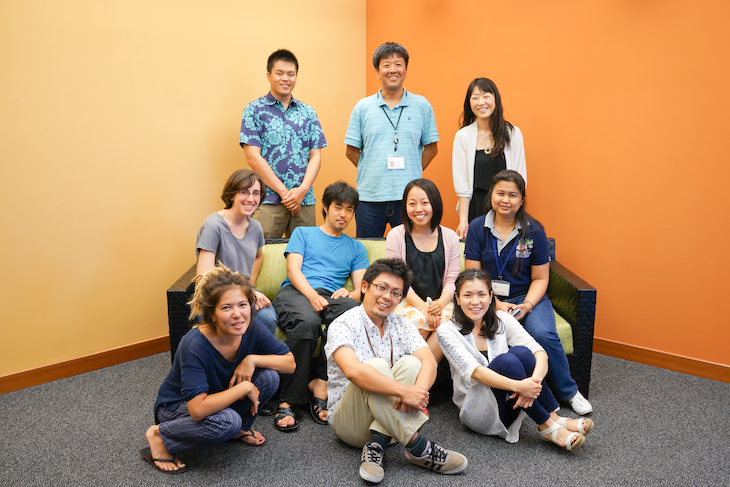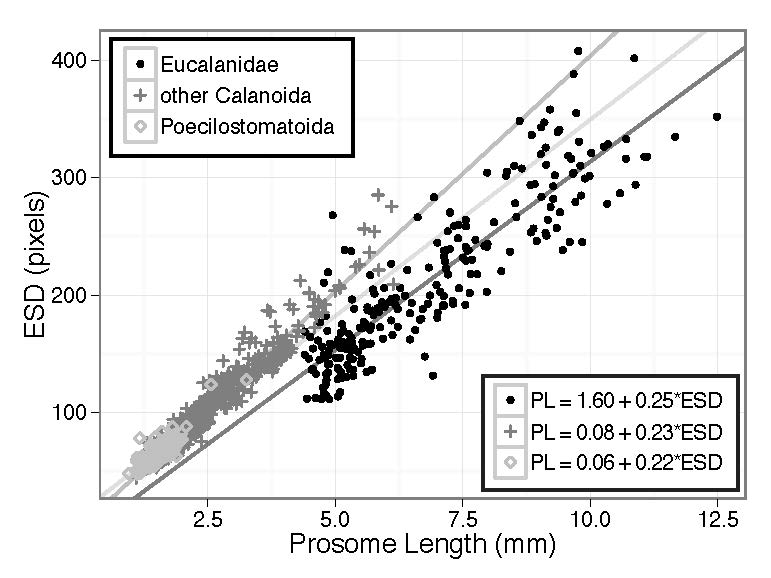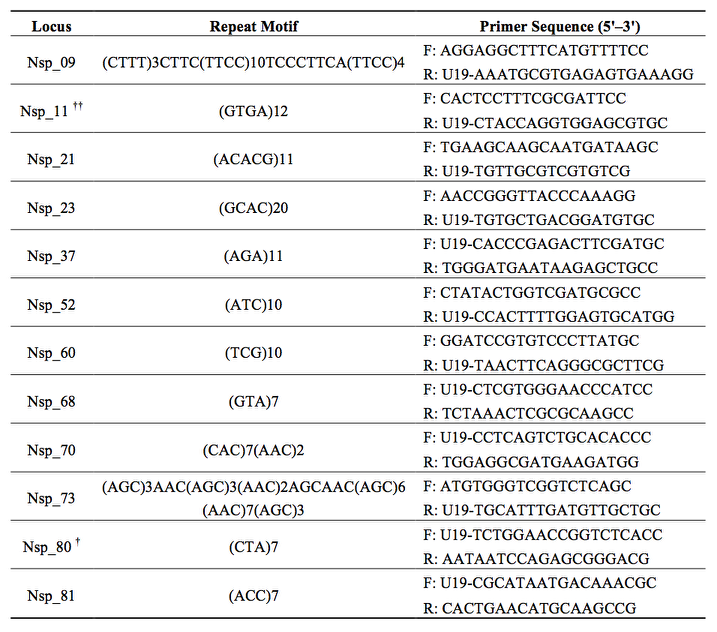FY2013 Annual Report
Marine Biophysics Unit
Assistant Professor Satoshi Mitarai

Abstract
-
Help marine biologists and geneticists estimate rates of gene flow among sites,
-
Enable public agencies to build and evaluate marine protected areas based on population connectivity, and
-
Provide marine ecologists with a modeling system for predicting the global and long-term dynamics of the marine ecosystem.
1. Staff
-
Satoshi Mitarai, Assistant Professor (September 2009–)
-
Masako Nakamura, Researcher (March 2010–)
-
Daisuke Hasegawa, Researcher (October 2011–March 2014)
-
Yuichi Nakajima, Researcher (August 2013–)
-
Mary Matilda Grossmann, Researcher (October 2013–)
-
Taichiro Sakagami, Technician (February 2010–August 2013)
-
Yukiko Murabayashi, Technician (July 2011–)
-
Shohei Nakada, Technician (August 2011–)
-
Yuta Nunome, Technician (May 2014–)
-
Chihiro Arasaki, Research Administrator (July 2012–)
Past Members:
-
Emile Trimoreau, Short-term Student (September 2010–February 2011)
-
Flora Vincent, Short-term Student (July 2011–December 2011)
-
Hirohito Yamazaki, Shor-term Student (August 2011–September 2011)
-
Fiona Francis, Internship Student (May 2012–August 2012)
-
MiHye Seo, Internship Student (October 2012–January 2013, July 2013–August 2013)
-
Yuki Kamidaira, Internship Student (August 2013–September 2013)
-
Shizuka Kuda, Research Administrator (February 2010–June 2012)
2. Collaborations
- Theme: Development of high frequency radar for surface ocean current monitoring
- Type of collaboration: Contract research
- Researchers:
- Prof. S. Fujii, University of the Ryukyus
- Theme: Larval dispersal of coral reef species
- Type of collaboration: Joint research
- Researchers:
- Prof. K. Sakai, University of the Ryukyus
- Theme: Larval dispersal of hydrothermal vent species
- Type of collaboration: Joint research
- Researchers:
- Dr. T. Maruyama, Japan Agency for Marine-Earth Science and Technology
- Dr. Y. Fujiwara, Japana Agency for Marine-Earth Science and Technology
- Dr. Y. Furushima, Japan Agency for Marine-Earth Science and Technology
- Dr. H. Watanabe, Japan Agency for Marine-Earth Science and Technology
- Theme: Regional ocean circulation modeling
- Type of collaboration: Joint research
- Researcher:
- Dr. J. McWilliams, University of Californina, Los Angels
- Dr. A. Shchepetkin, University of Californina, Los Angels
- Prof. Y. Uchiyama, Kobe University
- Dr. E. Gross, Stanford University
- Theme: Okinawa coastal ocean observing system
- Type of collaboration: Joint research
- Researchers:
- Mr. K. Hirate, Okinawa Prefectural Fisheries and Ocean Research Center
- 11th Regional Coast Guard Headquarters
- Mr. M. Toda, Okinawa Churaumi Aquarium
- Theme: Current patterns of Eastern Indonesia and their impact on larval dispersal
- Type of collaboration: Joint research
- Researchers:
- Dr. J. Kooyman, Scripps Institute Oceanography
- Dr. J. Sprintall, Scripps Institute Oceanography
- Theme: Study on mechanisms of chronic abundance and metapopulation connectivity of COTS in Onna coast
- Type of collaboration: Joint research
- Researchers:
- Dr. K. Okaji, Coral Quest Inc.
- Dr. K. Fukumura, Okinawa Environment Science Center
- Theme: Cruises for validating the measurements by using a fast free fall multi-sensor logger by using Tonan-maru
- Type of collaboration: Contract research
- Researchers:
- Mr. K. Hirate, Okinawa Prefectural Fisheries and Ocean Research Center
3. Activities and Findings
3.1 Quantification of connectivity in marine ecosystems around Okinawa
3.1.1 Connectivity of the Crown-of-Thorns Starfish around Okinawa
Boom and bust dynamics are a prominent characteristic of the Crown-of-Thorns Starfish (Acanthaster planci) populations. Outbreaking starfish populations damage coral communities extensively and then often disapper quickly. In contrast, Onna village, on the central west coast of Okinawa Island, Japan, has been experiencing chronically high population densities of A. planci for decades. In this study, we examined spatial and temporal population dynamics of A. planci along the coast of Onna village, using removal data gathered over 24 years by a local fisheries sooperative. The results demonstrate that A. planci populations along the Onna coast often experienced high densities prior to 2003, and that recently, populations have again been increasing drastically. Size-frequency distributions suggest multiple, successive recruitment, as one of the driving factors maintaining A. planci populations in this location. Moreover, within the Onna area, the timing of outbreak peaks varied among the different locations, showing a northward progression.

Figure 1: Site maps. a) Okinawa Island, Japan; b) Onna village, Okinawa; c) Research areas along the Onna coast. AF=Afuso, SR=Seragaki, MO=Minami Onna, MG=Maeganeku, MA=Maeda.

Figure 2: Densities of Acanthaster planci removed at five areas along the Onna coast from 1998 to 2012.
3.1.2 Continuous observation of plankton
Computer-automated image capture and analysis techniques are increasingly used for the study of plankton. Unfortunately, because most of the automatic image processing software packages recognize only numbers of pixels and grey scale values, although a great many parameters are automatically measured on each image (area, perimeter, average level of grey, etc….), these do not directly equate to variable that appear in the biological literature. The relationships between prosome lengths and computer-generated characters were derived from images acquired using the ZooScan system for two of the most common copepod families off south-eastern Japan: Calanoida and Poecilostomatoida. The equivalent spherical diameter (ESD), a character automatically measured by the ZooScan-ZooProcess system, was found to be highly correlated with prosome length in the two others, and a single equation could be established (regression coefficient r2=0.943) for all Calanoida excepting those of the family Eucalandiae: PL (mm)=0.08+0.023*ESD (pixels).


Figure 2: (Left) Illustration of the prosome length measurements applied to the calanoid family Eucalanidae (A), the order Poecilostomatoida (B), and all other calanoid copepods (C). D: Process of automatic measurement: Calanoid copepod as scanned (a), after outline (b), Area, in black, Perimeter, the contour if the black outline, and Maximum Feret's Diameter, grey line (c). All listed images were captured by ZooScan. Scale bar=1 mm. (Right) Relationships between the manually measured prosome length (PL) and the Equivalent Spherical Diameter (ESD) estimated by the ZooScan and ZooProcess system. Prosome length in mm, ESD in pixels.
3.1.3 Genetic connectivity of reef-building corals and deep-sea hydrothermal vent species
Barnacles of the genus Neoverruca are abundant near deep-sea hydrothermal vents of the northwestern Pacific Ocean, and are useful for understanding processes of population formation and maintenance of deep-sea vent faunas. Using next-generation sequencing, we isolated 12 polymorphic microsatellite loci from Neoverruca sp., collected
in the Okinawa Trough. These microsatellite loci revealed 2–19 alleles per locus. The expected and observed heterozygosities ranged from 0.286 to 1.000 and 0.349 to 0.935, respectively. Cross-species amplification showed that 9 of the 12 loci were successfully amplified for Neoverruca brachylepadoformis in the Mariana Trough. A pairwise FST value calculated using nine loci showed significant genetic differentiation between the two species. Consequently, the microsatellite markers we developed will be useful for further population genetic studies to elucidate genetic diversity, differentiation, classification, and evolutionary processes in the genus Neoverruca.

Figure 3: Sampling sites for Neoverruca. Iheya North field (for Neoverruca sp.) is located in the Okinawa Trough and the Alice Springs field (N. brachylepadoformis) is in the Mariana Trough.

Table 1: Characteristics of the 12 developed polymorphic microsatellite loci in 15 individuals of Neoverruca sp. Columns show the locus name, the primer sequence, the repeat motif.
4. Publications
4.1 Journals
- Grossmann, M. M. & Lindsay, D. J. Estimation of calanoid copepod prosome length from pixel-based measurements derived from the ZooScan and ZooProcess systems. Bulletin of Plankton Society of Japan 61, 91-94 (2014).
- Lindsay, D. J., Yamaguchi, A., Grossmann, M. M., Nishikawa, J., Sabates, A., Fuentes, V., Hall, M., Sunahara, K. & Yamamoto, H. Vertical pro_les of marine particulates: a step towards global scale comparisons using an Autonomous Visual Plankton Recorder. Bulletin of Plankton Society of Japan 61, 72-81 (2014).
- Grossmann, M. M., Collins, A. G. & Lindsay, D. J. Description of the eudoxid stages of Lensia havock and Lensia leloupi (Cnidaria: Siphonophora: Calycophorae), with a review of all known Lensia eudoxid bracts. Systematics and Biodiversity 12, 163-180, doi:10.1080/14772000.2014.902867 (2014).
- Nakamura, M., Watanabe, H., Sasaki, T., Ishibashi, J., Fujikura, K. & Mitarai, S. Life history traits of Lepetodrilus nux in the Okinawa Trough, based upon gametogenesis, shell size, and genetic variability. Marine Ecology Progress Series 505, 119-130, doi:10.3354/meps10779 (2014).
- Shinzato, C., Yasuoka, Y., Mungpakdee, S., Arakaki, N., Fujie, M., Nakajima, Y. & Satoh, N. Development of novel, cross-species microsatellite markers for Acropora corals using next-generation sequencing technology. Frontiers in Marine Science 1, 1-5, doi:10.3389/fmars.2014.00011 (2014).
- Nakajima, Y., Shinzato, C., Khalturina, M., Watanabe, H., Inagaki, F., Satoh, N. & Mitarai, S. Cross-Species, Amplifiable Microsatellite Markers for Neoverrucid Barnacles from Deep-Sea Hydrothermal Vents Developed Using Next-Generation Sequencing. International Journal of Molecular Sciences 15, 14364-14371, doi:10.3390/ijms150814364 (2014).
4.2 Oral Presentations
- Mitarai, S. & Nakamura, M. Larval dispersal and metapopulation dynamics of hydrothermal vent species, in Ecology of Hydrothermal System: Ecosystem Research and Environmental Impact Assessment, Chiba, Japan (2013).
- Nakamura, M. & Mitarai, S. Biogeographic variation in larval dispersal and recruitment in an era of climate change and ocean acidification in LOV Regular Seminar, Nice, France (2013).
- Nakamura, M. & Mitarai, S. Larval dispersal and metapopulation dynamics of hydrothermal vent species, in Canon Foundation Persuit-of-Dreams grant symposium, Tokyo, Japan (2013).
- Nakamura, M., Mitarai, S., Higa, Y. & Okaji, K. Population dynamics of corallivore starfish Acanthaster planci along Onna coast, Okinawa, in 2013 Joint Meeting of Japanese Association of Benthology & The Plankton Society of Japan, Miyagi, Japan (2013).
- Mitarai, S. & Grossmann, M. Establishing World-Class Coral Reef Ecosystem Monitoring in Okinawa, in 16th Japanese Coral Reef Society Meeting, Okinawa, Japan (2013).
- Nakamura, M., Mitarai, S., Higa, Y., Yasuda, N., Yamakawa, E., Ogasawara, K. & Okaji, K. Ecology of Acanthaster planci along the Onna coast, in 16th Japanese Coral Reef Society Meeting, Okinawa, Japan (2013).
- Nakamura, M., Sakai, K., Higa, Y., Okaji, K. & Mitarai, S. Larval dispersal and recruitment of corals and Crown-of-Thorns starfish around Okinawa Island, Japan, in 2014 Ocean Sciences Meeting, Hawaii, USA (2014).
- Hasegawa, D., Hirate, K. & Mitarai, S. Large meander of the Subtropical Counter Current, in The Oceanographic Society of Japan Spring Meeting 2014, Tokyo, Japan (2014).
4.3 Poster Presentations
- Grossmann, M. M., Lindsay, D. J. & Collins, A. G. The Combination of Morphological and Genetic Data Sheds Light on Decade-Old Taxonomic Mysteries in Cnidarian Siphonophores, in 2014 Ocean Sciences Meeting, Hawaii, USA (2014).
- Hasegawa, D. & Mitarai, S. Developing a Bio-UCTD Probe, in 2014 Ocean Sciences Meeting, Hawaii, USA (2014).
- Mitarai, S., Nakamura, M., Watanabe, H. & Shchepetkin, A. Larval Dispersal of Hydrothermal Vent Species in the Western Pacific, in 2014 Ocean Sciences Meeting, Hawaii, USA (2014).
5. Intellectual Property Rights and Other Specific Achievements
5.1 External funding
- Pursuit of Dream Grant, Canon Foundation, “Larval dispersal and metapopulation dynamics of hydrothermal vent species”, Lead PI: S. Mitarai (OIST), Co-PIs: N. Satoh, H. Kitano, T. Maruyama, Y. Fujiwara, Y. Furushima, H. Watanabe (Japan Agency for Marine-Earth Science and Technology), Amount: 38M Yen, Period: Apr 2011–Mar 2014.
-
Grants-in-Aid for Scientific Research C, Japan Society for the Promotion of Science, “Quantification of spatio-temporal variability in recruitment at hydrothermal vents”, Lead PI: M. Nakamura (OIST), Co-PIs: H. Watanabe (Japan Agency for Marine-Earth Science and Technology), T. Sasaki (University of Tokyo), Amount: 4.3M Yen, Period: Apr 2012–Mar 2016.
-
Strategic Information and Communications R&D Promotion Programme, Ministry of Internal Affairs and Communications, “Development of high-frequency radars for Okinawa coral reefs”, Lead PI: S. Fujii (University of the Ryukyus), Co PI: S. Mitarai, Amount: 19M Yen, Period: July 2012–Mar 2014.
-
TaKaRa Scientific Grants, “Study on the larval dispersal patterns of Crown-of-Thorns starfish along Onna coast, Okinawa.”, Lead PI: M. Nakamura (OIST), Co-PIs: None, Amount: 480K Yen, Period: June 2013–May 2015.
-
Grant-in-Aid for Young Scientists B, Japan Society for the Promotion of Science, "Elucidation of dynamics and connectivity in marine species at multiple scales for coastal ecological conservation in the Nansei Islands", Lead PI: Y. Nakajima (OIST), Amount: 4.3M Yen, Period: Apr 2013–Mar 2016.
-
Grant for investigative study and activity for nature conservation in the Nansei islands/Pro Natura Foundation, Japan, "Conservation genetic study in multiple scales for reef-building corals inhabit the Nansei Islands", Lead PI: Y. Nakajima (OIST), Co-PIs: S. Mitarai, C. Shinzato, Amount: 2.9M Yen, Period: Oct 2013–Sep 2015
6. Meetings and Events
Nothing to report
7. Others
Nothing to report



